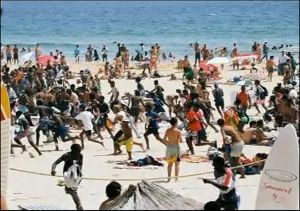"Arrastão" - Police intervention and media coverage
On the 10th of June, the prime time TV news of the three main terrestrial channels (RTP1, SIC and TVI) opened with the coverage of “a riot” in Carcavelos’ beach, on the outskirts of Lisbon. The beach was full – it was a national holiday marking the Day of Portugal – and the news showed images of black teenagers running and police officers holding guns on the beach.
In TV broadcasts, the riot was called an “arrastão”, which literally means dragnet, a Brazilian term used in trying to draw a parallel with the events on the beaches of Rio de Janeiro (Brazil) during the 90’s, where teenagers swept down the beach, scooping up other people’s belongings. Following the comments made by a police officer on the scene, the media described scenes of utter chaos, reporting that around 500 black teenagers had stormed down the beach, attacking and stealing from everyone in their path as panicked citizens scrambled for refuge from the violence. “Horror”, “panic” and “chaos” were words abundantly used on TV news as well as in the newspapers’ front pages in the following day. News of this event were also broadcasted in international TV stations such has Euronews and BBC.
In the ensuing days, there was a nation-wide public debate which directly linked criminality, in particular gang criminality, and black youngsters descendant of immigrants in Portugal. The Government strengthened security on beaches while opposition asked for harder security measures to be taken.
Despite this climate, one week later, newspaper headlines, quoting a police report, stated that only 30 or 40 individuals participated in illicit acts on the beach and there was no evidence of organised crime. The teenagers seen on the photos were on the run but they were not muggers, it was also added. Only one complaint was presented to the police. In the latest police report (July, the 19th), the incidents were not totally clarified but they were adamant that an “arrastão” had not occurred.
In response to the racist and xenophobic atmosphere, the Alto Comissário para a Imigração e as Minorias Étnicas [High Commissariat for Immigration and Ethnic Minorities] felt the need to point out that “the problem is not the colour of the skin but the social exclusion”. The CICDR - Comissão para a Igualdade e Contra a Discriminação Racial [Commission for Equality and Against Racial Discrimination] made a public statement in response to the “strengthening of the stigmatization of immigrants and ethnic minorities.” Later, the independent journalist Diana Andringa made some research on the events and presented the video “Era uma vez um arrastão” (Once upon a time a dragnet) which shows that no massive and organised action of black teenagers took place in Carcavelos. The video was made with the explicit aim of acting on that precise situation, trying to counteract what was perceived as a growth on a widespread attitude of racism, xenophobia and mistrust towards a particular group, in that case black youths. With the aim of reaching the vastest possible audience, the video was rapidly made available online and presented publicly on July 30.
A few days after the events that took place on Carcavelos' beach and at the same time as a major far-right manifestation was being held in Lisbon, President Jorge Sampaio visited one of the most stigmatised and poor neighbourhoods on the outskirts of Lisbon, Cova da Moura, inhabited mostly by immigrants from former Portuguese colonies in Africa and their descendents, from where some of the supposed robbers of the “arrastão” were supposed to be. The President took the occasion to explicitly condemn xenophobia and media dogmatism.
NGO’s and academic researchers also warned against the dangers of media demagogy and the rise of racist and xenophobic feelings as well as of unfounded stereotypes which convey negative images on whole groups, in this case the association between immigrants and their descendents and crime. These warnings, however, had less resonance than the alarming news following the case of the supposed “arrastão”.
Sources:
-
SIC Tv, 10.06.2005, http://www.youtube.com/watch?feature=player_detailpage&v=ZjXtTfnaams
-
Jornal Público,10.06.2005, http://www.publico.pt/Local/psp-efectua-varias-detencoes-na-praia-de-carcavelos-1225508
-
Jornal Público,10.06.2005, http://www.publico.pt/Local/numero-de-agentes-da-policia-maritima-reforcado-em-carcavelos_1225514
-
Diário de Notícias, 11.06.2005, http://www.dn.pt/inicio/interior.aspx?content_id=602421
-
Correio da Manhã, 14.06.2005, http://www.cmjornal.xl.pt/noticia.aspx?channelid=00000010-0000-0000-0000-000000000010&contentid=00163379-3333-3333-3333-000000163379&goComments=11
-
Jornal Público,16.06.2005,http://www.publico.pt/Sociedade/arrastao-de-carcavelos-policia-suspeita-de-crime-organizado-mas-nao-tem-provas-1226152
-
Diário de Notícias, 12.07.2005, http://www.dn.pt/inicio/interior.aspx?content_id=616161
-
Jornal Público,19.07.2005, http://www.publico.pt/Sociedade/psp-nega-arrastao-na-praia-de-carcavelos-1228588
-
Correio da Manhã, 19.07.2005, http://www.cmjornal.xl.pt/detalhe/noticias/nacional/portugal/arrastao-deixa-marcas-em-carcavelos
-
Jornal de Notícias, 20.07.2005, http://www.jn.pt/paginainicial/interior.aspx?content_id=504380
-
Jornal Público, 25.11.2005, http://www.publico.pt/Media/arrastao-trabalho-dos-media-revelou-evidente-falta-de-rigor-informativo-isencao-e-objectividade-1240081
-
Diário de Notícias, 10.06.2006, http://www.dn.pt/inicio/interior.aspx?content_id=641805

